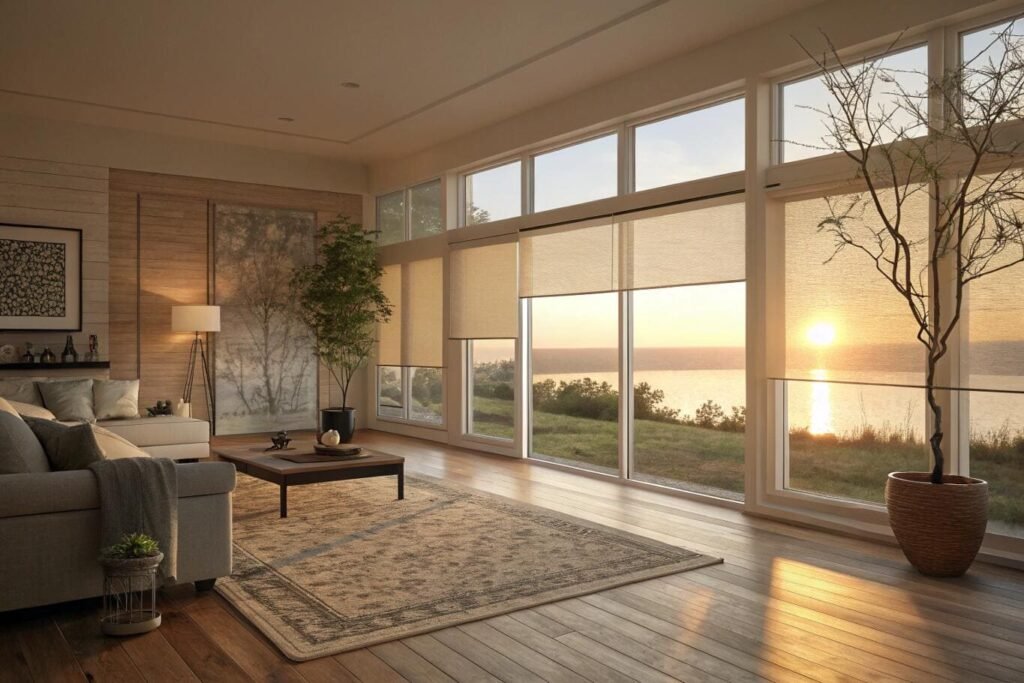Are you confused by the array of solar shade fabrics and unsure which offers the best performance for your project? Choosing the right material impacts glare, heat, and view, making a significant difference to a space's comfort and energy efficiency.
Solar shade fabrics like polyester and fiberglass, often PVC-coated screen materials, offer distinct benefits for sun control. Polyester provides flexibility and strong color options, while fiberglass offers superior dimensional stability and fire resistance, each excelling in different project requirements.
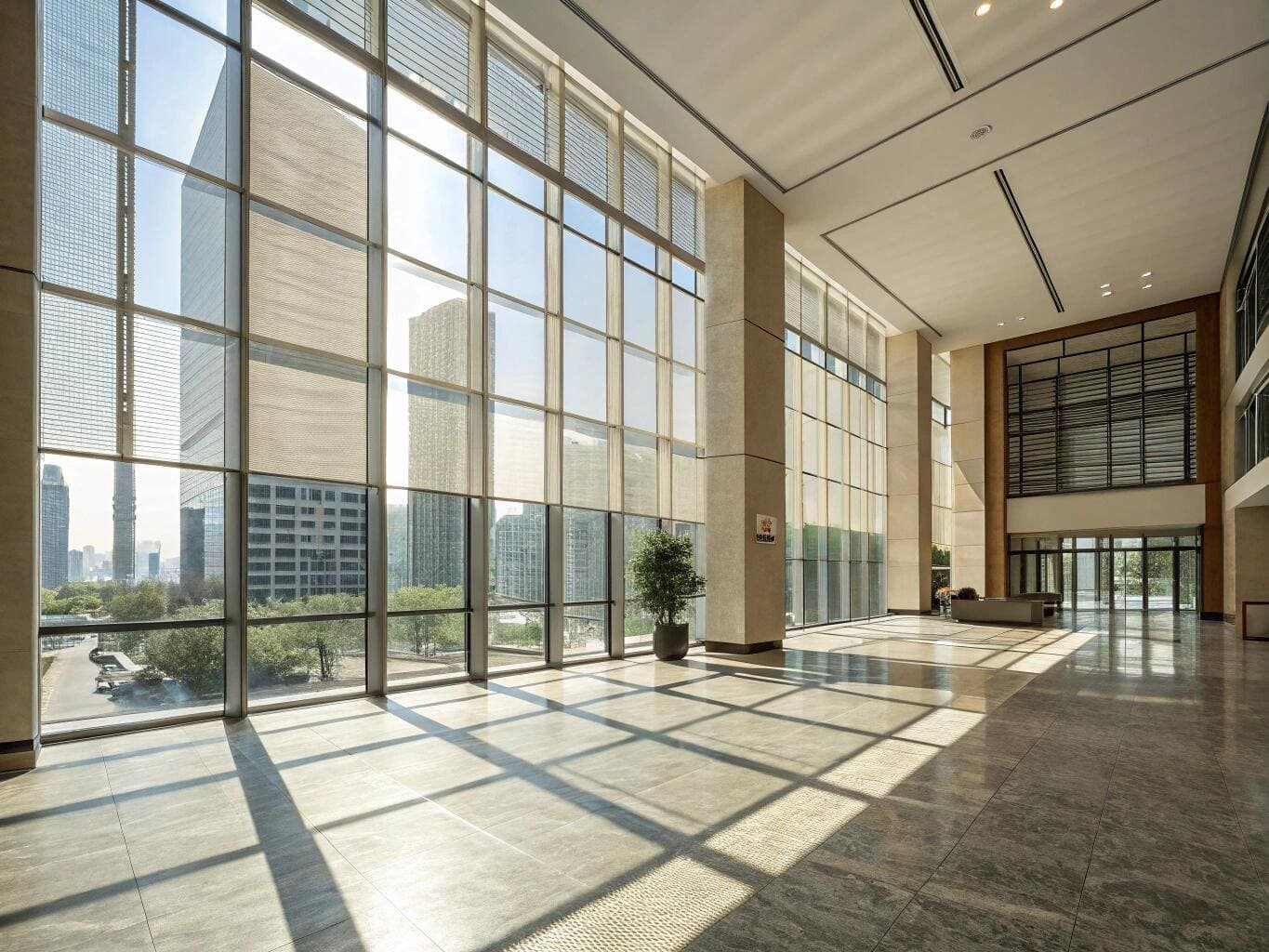
As a provider of smart shading solutions, I often guide project managers and designers through the complexities of material selection. The choice of solar shade fabric is not just about aesthetics; it is about balancing durability, performance, and cost to deliver solutions that truly excel. Let us dive into the specifics of polyester[^1], fiberglass, and other screen materials to help you make informed decisions for your next project.
Which is better, fiberglass or polyester screen?
With various solar shade fabrics available, are you puzzled about choosing between fiberglass[^2] and polyester? Each material has unique strengths and weaknesses that directly impact performance, durability, and suitability for different environments.
Choosing between fiberglass and polyester for solar shades depends on priority: fiberglass offers superior fire retardancy, dimensional stability, and heat resistance, making it ideal for commercial spaces, while polyester provides better tensile strength, flexibility, tear resistance, and vivid color options, suitable for diverse residential and commercial applications.
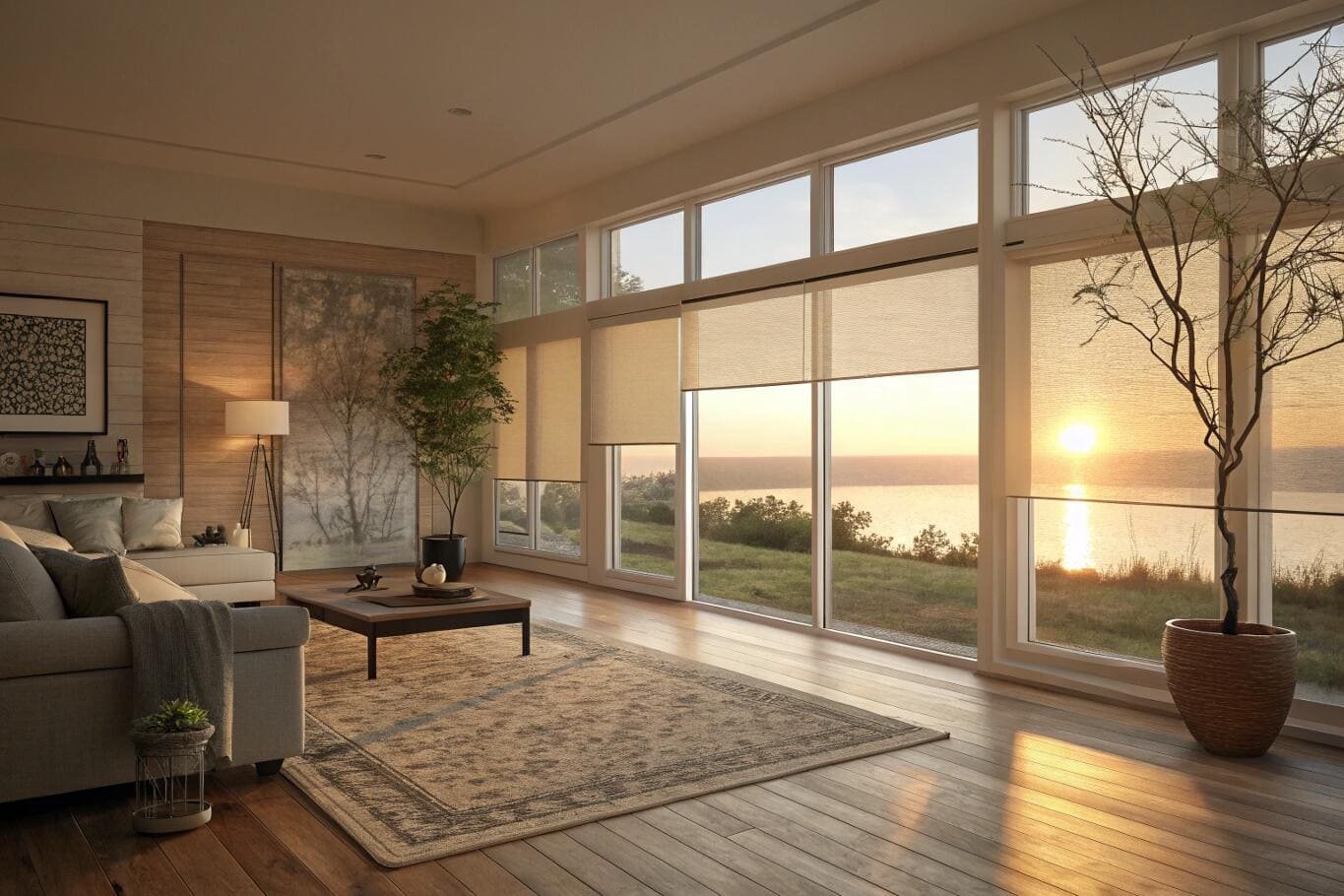
From my perspective, both fiberglass and polyester, when PVC-coated, deliver high performance for solar shade applications. However, their fundamental fiber properties lead to distinct advantages that make one "better" than the other for specific project needs. Here is how they compare based on critical performance metrics:
| Feature | Polyester Solar Screens | Fiberglass Solar Screens |
|---|---|---|
| Material Composition | Polyester fibers coated with PVC. | Woven fiberglass yarns coated with PVC. |
| Dimensional Stability | Good, but can exhibit slight stretch or shrinkage under extreme temperature fluctuations. | Excellent, highly stable, resisting stretching or shrinking, even with large shades or significant temperature changes. |
| Tensile Strength | High, very durable and resistant to tearing or puncturing [simulated data]. | Good, but the inherent brittleness of glass fibers can make it less flexible; can be more prone to creasing if mishandled. |
| Fire Retardancy | Good, often meets fire retardant standards (e.g., B1 level) due to PVC coating. | Excellent, inherently non-combustible and fire resistant due to glass composition [5]. Ideal for demanding fire safety requirements. |
| Heat Resistance | Good, generally performs well in solar control. | Superior, highly resistant to heat and UV radiation without degradation over time. |
| Moisture Resistance | Excellent due to PVC coating. | Excellent due to PVC coating . |
| Appearance/Aesthetics | Smoother, more pliable, often allows for richer, more vibrant and diverse color options. | Slightly stiffer, can appear more rigid; color palette might be more subdued or limited compared to polyester due to glass fiber properties. |
| Durability | Very durable, known for resilience against tears and abrasions. | Very durable against environmental factors like heat and UV, but can be brittle against physical impact. |
| Weight | Generally lighter weight. | Slightly heavier due to the glass content. |
| Cost | Often slightly more economical. | Can be slightly higher in cost. |
For projects where fire safety is a paramount concern, such as in schools, hospitals, or large commercial buildings, fiberglass is often the preferred choice due to its inherent non-combustibility. Its superior dimensional stability is also beneficial for very large window applications where maintaining precise shape is critical. However, for a balance of excellent durability, a wider range of aesthetic options, and slightly better tear resistance for high-traffic or residential areas, polyester stands out. Both materials effectively offer excellent sun control, thermal regulation, and reduce glare . The "better" material truly depends on balancing the specific demands of your project.
What is the advantages and disadvantages of polyester?
Are you considering polyester for your solar shades but unsure about its full potential and any potential limitations? Understanding its benefits and drawbacks is crucial for a smart decision that aligns with your project's goals.
Polyester solar shade fabrics offer high tensile strength, excellent tear resistance, and a wide range of aesthetic options, making them versatile for many applications. Their main disadvantages include potential for greater dimensional instability under extreme heat compared to fiberglass and a generally lower inherent fire resistance compared to fiberglass before PVC coating.

From my experience, polyester solar shade fabrics[^3] coated with PVC are a highly popular choice due to their versatility and performance in a wide array of applications.
Advantages of Polyester Solar Shades:
- High Tensile and Tear Strength: Polyester fibers inherently possess exceptional strength, making these shades highly resistant to tearing, puncturing, and general wear and tear. This is particularly advantageous in high-traffic commercial environments or residential settings with children and pets, where durability[^4] against physical stress is critical [simulated ASTM D5034-20 - Breaking Strength and Elongation of Textile Fabrics].
- Aesthetic Versatility: Polyester takes dyes well, allowing for a broader spectrum of colors, patterns, and textures. This provides greater design flexibility for interior designers and architects looking to match specific aesthetic visions. Its smoother drape also contributes to a more refined appearance.
- Dimensional Stability (Good): While not as superior as fiberglass in extreme conditions, polyester fabrics still offer good dimensional stability[^5] due to their PVC coating, resisting stretching and shrinking under typical environmental fluctuations.
- Moisture, Dust, and Anti-static Resistance: PVC-coated polyester fabrics are resistant to moisture, making them easy to clean and maintain. They are also anti-static and dust-resistant, contributing to a cleaner indoor environment and requiring less frequent maintenance.
- UV Protection and Glare Reduction: Like fiberglass, polyester solar shades are highly effective at blocking harmful UV rays and reducing sun glare, protecting interiors and enhancing visual comfort.
Disadvantages of Polyester Solar Shades:
- Lower Inherent Fire Resistance: While PVC-coated polyester can meet fire retardancy standards (like China GB8624-B1, NFPA701, BS5867), this property largely depends on the coating rather than the fiber itself [5]. In extremely stringent fire-rated environments, fiberglass's natural non-combustibility might be preferred.
- Dimensional Stability (Compared to Fiberglass): In very large-scale installations or environments with extreme and rapid temperature swings, polyester might exhibit slightly more dimensional change (minimal stretching or sagging) compared to the absolute steadfastness of fiberglass. This is usually only a concern for highly specific, precision-driven projects.
- Susceptibility to Creasing: While flexible, if repeatedly creased aggressively, polyester fabrics might show signs of it more readily than some very rigid fiberglass counterparts.
Ultimately, for most residential and many commercial projects, the advantages of polyester solar shades in terms of tear resistance, aesthetic options, and overall durability often outweigh their minor drawbacks.
What is the advantages and disadvantages of fiberglass?
Are you evaluating fiberglass for your solar shade needs and need a complete picture of its strengths and weaknesses? Knowing its specific characteristics is key to optimal selection for demanding environments.
Fiberglass solar shade fabrics boast superior dimensional stability, excellent fire retardancy, and high heat resistance, ideal for demanding commercial or public spaces. However, they can be more brittle, potentially less resistant to creasing if mishandled, and may offer fewer vibrant color options than polyester.
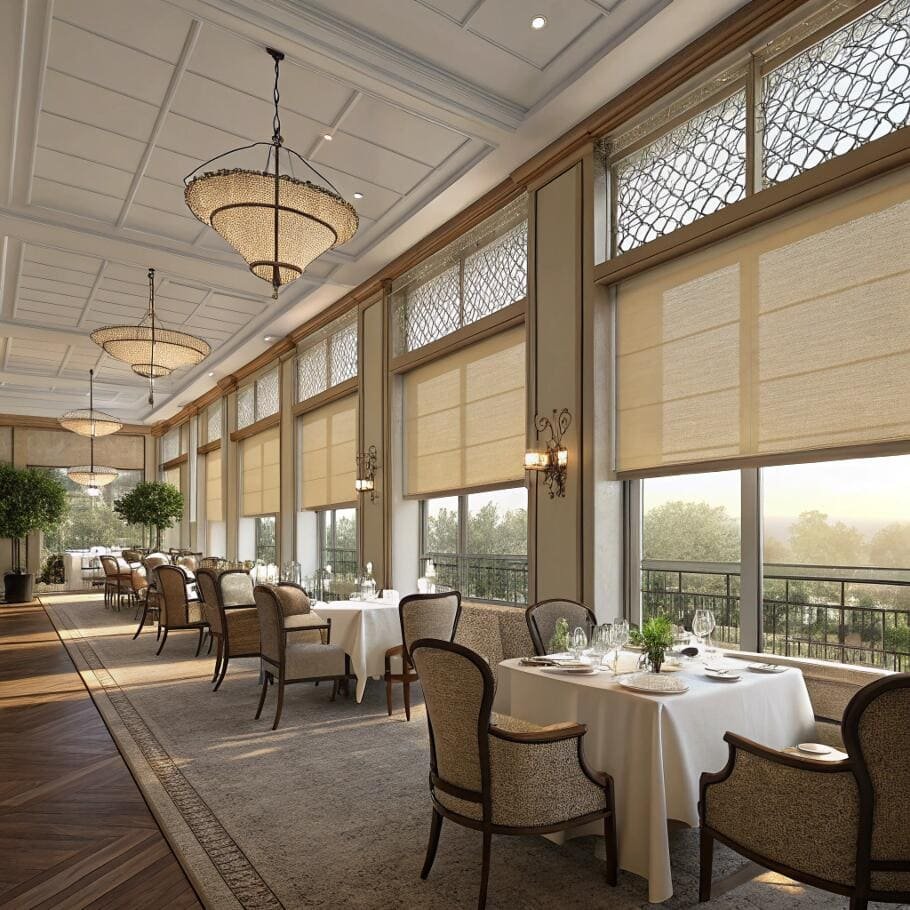
Fiberglass solar shades are engineered to meet the stringent demands of high-performance environments, leveraging the intrinsic properties of glass fibers.
Advantages of Fiberglass Solar Shades:
- Superior Dimensional Stability: This is perhaps fiberglass's strongest advantage. The woven glass fibers resist stretching, shrinking, or sagging significantly, maintaining their precise shape even across large window expanses and under fluctuating temperatures. This consistency ensures flawless operation and a neat appearance over many years [simulated ASTM D882 - Tensile Properties of Thin Plastic Sheeting].
- Excellent Fire Retardancy: Fiberglass is non-combustible by nature. This makes fiberglass solar shades inherently fire resistant, a critical safety feature for public buildings, hotels, schools, and any commercial space where fire safety codes are rigorous. They typically meet international fire safety standards like NFPA701, BS5867, and China GB8624-B1 (B1 level) .
- High Heat and UV Resistance: Fiberglass can withstand prolonged exposure to intense direct sunlight and high temperatures without degrading, yellowing, or becoming brittle. This ensures long-term performance and contributes to effective thermal control by reflecting solar heat.
- Durability and Easy Maintenance: Like polyester, PVC-coated fiberglass is highly durable against environmental factors. It is also moisture-resistant, anti-static, and dust-resistant, contributing to easy cleaning and low maintenance .
- Effective Glare and UV Control: Fiberglass fabrics with appropriate openness factors are highly effective at reducing sun glare and blocking harmful UV rays, protecting building occupants and interior furnishings .
Disadvantages of Fiberglass Solar Shades:
- Brittleness: While strong against pulling forces, fiberglass can be more brittle than polyester. This means it might be more susceptible to damage from sharp impacts or repeated creasing if mishandled during installation or transport. Care must be taken to avoid sharp folds.
- Limited Aesthetic Options: Due to the nature of glass fibers, fiberglass fabrics typically offer a more restricted range of colors and textures compared to polyester. Achieving very vibrant or complex patterns can be challenging, which might limit design choices for projects prioritizing a wide aesthetic palette.
- Weight: Fiberglass fabrics are generally slightly heavier than polyester fabrics of comparable density. While usually not a significant factor, it can be a minor consideration for very large shades or specific motor systems that require lighter loads.
- Cost: Fiberglass solar shade fabrics tend to have a higher price point than polyester alternatives. This higher initial investment is often justified by their superior performance in specialized applications, particularly those with strict fire safety requirements.
Despite these disadvantages, fiberglass remains an unparalleled choice for projects where uncompromising performance in fire safety, dimensional stability, and heat resistance is the primary requirement.
How to tell the difference between fiberglass and polyester fibers?
Are you unsure how to identify the material of a solar shade fabric in hand, especially when evaluating samples for a project? Distinguishing between fiberglass and polyester can be challenging without proper knowledge, but there are practical ways to tell them apart.
To differentiate fiberglass from polyester solar shade fabrics, primarily observe their texture, flexibility, and, for professional assessment with extreme caution, perform a controlled burn test. Fiberglass typically feels stiffer and coarser, while polyester is softer and more pliable; fiberglass will inherently resist flame without melting, whereas polyester will melt, burn, and potentially drip.
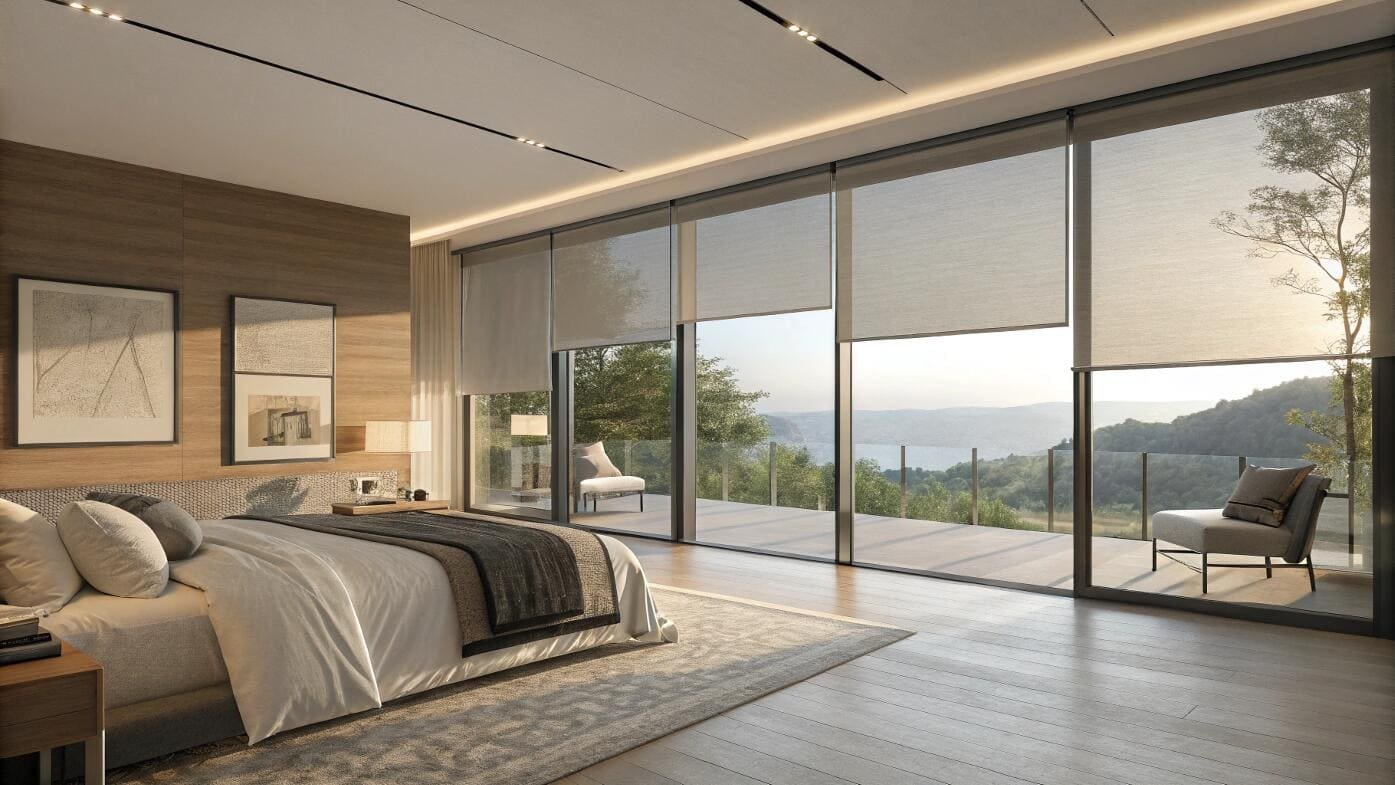
Identifying the base fiber of a solar shade fabric is important for confirming specifications and understanding performance characteristics. Here is how I usually recommend discerning between fiberglass and polyester:
1. Feel and Texture:
- Fiberglass: When you touch or rub fiberglass fabric, it often feels stiffer, more rigid, and can sometimes have a slightly "gritty" or even slightly prickly sensation, especially if the PVC coating is thin or worn. This is due to the inherent nature of the woven glass fibers.
- Polyester: Polyester fabrics tend to feel softer, smoother, and more pliable to the touch. They have a distinct textile-like feel, similar to other fabrics composed of synthetic fibers.
2. Flexibility and Drape:
- Fiberglass: Fiberglass fabrics will feel less flexible and more rigid. If you try to crumple a small piece, it might resist and spring back more, holding a somewhat defined shape. It has a stiffer, more structured drape.
- Polyester: Polyester fabrics are noticeably more flexible and will have a softer, more fluid drape. They will crumple more easily and feel less resistant to manipulation.
3. Visual Inspection (Magnification Recommended):
- Fiberglass: Under a magnifying glass (or even strong reading glasses), you might be able to see distinct, uniform glass fibers woven together. The weave often appears very tight and compact.
- Polyester: Polyester fibers might appear slightly more irregular or fibrous, and the weave might seem less rigid.
4. Burn Test (For Professionals Only – Extreme Caution Required!):
This test is definitive but should only be performed by trained professionals in a controlled environment with proper safety equipment and ventilation. It is NOT recommended for general use due to fire hazards.
- Fiberglass: When a small, isolated piece of fiberglass fabric (without excessive PVC) is exposed to a flame, it will not typically ignite or sustain a flame. The glass fibers are inherently non-combustible. They will char and melt at very high temperatures, forming a hard, brittle residue, but they will not drip or spread fire. The material is self-extinguishing.
- Polyester: When a small piece of polyester fabric is exposed to a flame, it will usually melt, curl away from the flame, and may ignite and drip. If it burns, it often produces a sweet, chemical odor. It typically self-extinguishes when the flame source is removed, but the melting and dripping behavior is distinct.
By carefully assessing these characteristics, particularly the feel, flexibility, and visual texture, you can generally distinguish between fiberglass and polyester solar shade fabrics.
What is the best material for Solar shades?
Facing multiple choices for solar shade materials, are you wondering which option truly stands out as the "best" for your project's unique needs? The optimal choice isn't always obvious, as "best" is relative to the specific application.
The "best" material for solar shades is subjective and depends on specific project requirements like fire safety, durability, budget, and desired aesthetics. Fiberglass excels in stability and fire resistance, making it ideal for high-traffic commercial spaces, while polyester offers superior tear resistance and aesthetic versatility for broader applications, each delivering effective sun control.
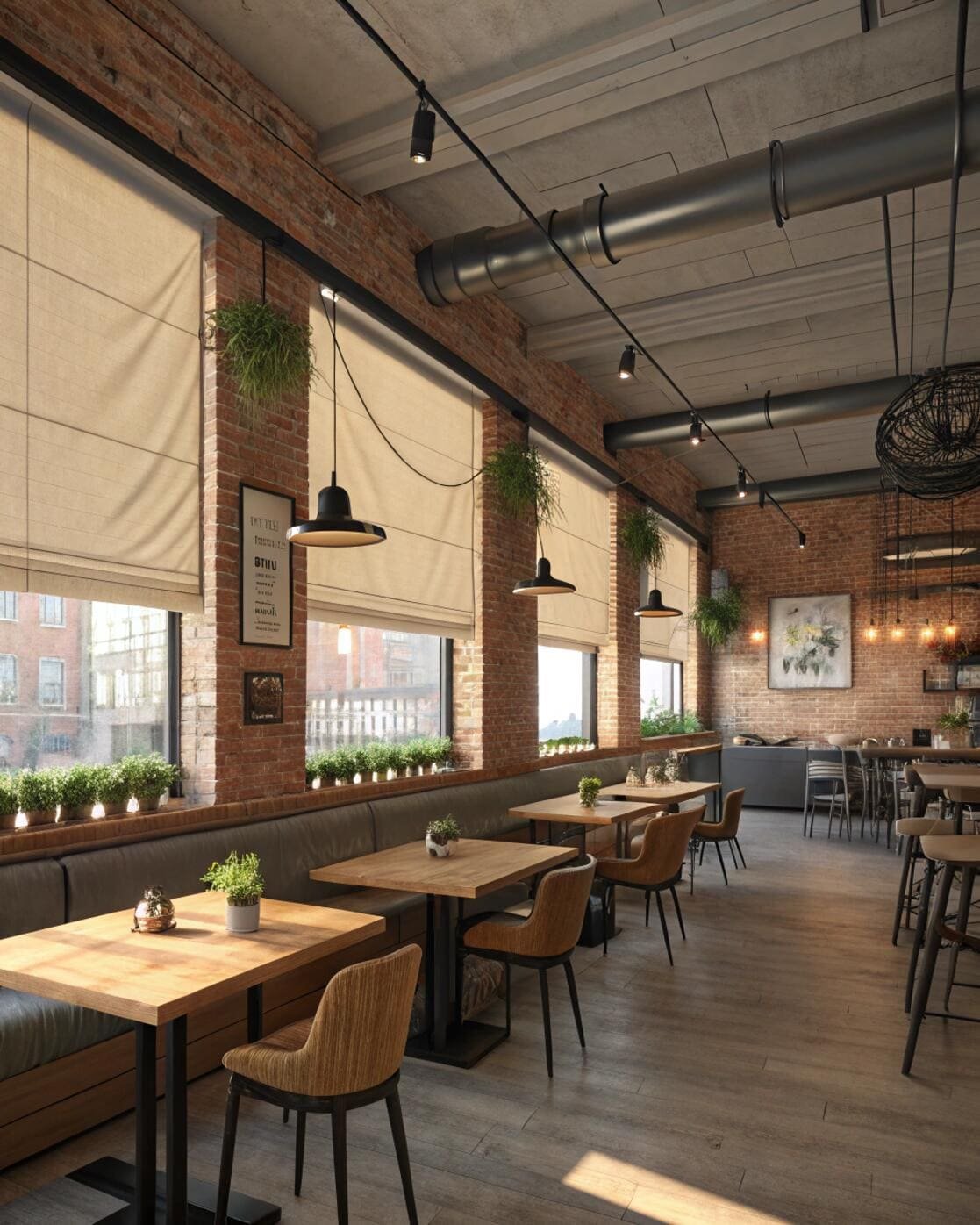
In my experience, there is no single "best" material that fits all solar shade applications. Instead, the most effective approach is to identify the right material for the specific project's priorities and environmental conditions. Here are the key factors I advise clients to consider:
-
Project Type and Regulations:
- Commercial/Public Spaces (e.g., hotels, hospitals, schools, offices): These often have stringent fire safety codes (like NFPA701, BS5867, China GB8624-B1). In such cases, fiberglass is almost always the superior choice due to its inherent non-combustibility and excellent fire retardancy. Dimensional stability for large glass facades is also a key factor here.
- Residential/General Commercial: For homes, apartments, or smaller commercial buildings where fire codes are less strict (but still important), polyester offers a fantastic balance of durability, aesthetics, and cost-effectiveness.
-
Performance Requirements:
- Dimensional Stability: For very large windows, roller shades, or applications in environments with significant temperature swings where maintaining precise non-sagging form is crucial, fiberglass offers unparalleled stability.
- Tear/Impact Resistance: In areas with potential for physical contact, high traffic, or where pets and children are present, polyester's superior tear and puncture resistance might make it more durable against daily stresses.
- Heat & UV Control: Both materials, when properly constructed and coated with PVC, are highly effective at blocking harmful UV rays and managing solar heat gain based on their openness factor . For maximum heat rejection, look for fabrics with metallized backing .
-
Aesthetics and Design Flexibility:
- If a wide range of colors, textures, and patterns are critical, or if a softer, more pliable drape is desired, polyester typically offers more versatility.
- If a more rigid, clean, and minimalist look with potentially fewer color options is acceptable, fiberglass can deliver.
-
Budget:
- Polyester generally presents a more economical solution, making it a great value for projects where budget is a significant consideration without compromising on quality or core performance benefits.
- Fiberglass, while often slightly more expensive, justifies its cost through its superior fire safety and dimensional stability in specialized high-performance applications.
For example, a south-facing executive office in a commercial tower might benefit most from dark fiberglass solar shades with a low openness factor and metallized backing for maximum glare and heat control, along with fire safety compliance . Conversely, a lively family living room might prefer a lighter, more textured polyester solar shade with a 3-5% openness for diffused light, privacy, and tear resistance against active children .
Ultimately, the goal is to assess your project's primary objectives. If fire safety and absolute dimensional stability in extreme environments are paramount, fiberglass is often the superior choice. For projects where budget flexibility, a wider aesthetic range, and excellent all-around durability are key, polyester is an outstanding option. Both materials are easy to maintain and contribute to energy efficiency by controlling sun ingress .
Conclusion
Choosing solar shade fabric comes down to balancing project needs. Both polyester and fiberglass offer excellent sun control and durability. Understanding their unique strengths ensures you select the perfect material for optimal performance and aesthetics that match your specific application.
Partner for Optimal Shade Solutions
Looking for the perfect solar shade fabric for your next building or renovation project? Do not settle for guesswork when it comes to performance and aesthetics. Contact VelaBlinds today to discuss your specific requirements, receive expert recommendations, and get a tailored quote for high-performance solar screening solutions that fit your budget and design vision.
Email us at: info@velablinds.com
Extended FAQ Section
What is the 'openness factor' in solar shades and why is it important?
The openness factor (or weave density) is a crucial metric in solar shades, typically ranging from 1% to 14% . It measures how much light, heat, and UV radiation passes through the fabric, and critically, how much outward visibility is maintained . A lower percentage (e.g., 1-3%) signifies a tighter weave, offering maximum privacy, glare, and heat reduction, while a higher percentage (e.g., 7-10%) provides excellent outward clarity but less privacy and heat control. This factor directly impacts outward visibility, daytime privacy, and sunlight blockage. For example, a 3-5% openness factor is often considered the "sweet spot" for most residential uses, providing good outward visibility while maintaining daytime privacy. Project buyers should select an openness factor based on the specific light control, privacy needs, and desired outward view for each space, especially in commercial settings where maintaining views is often important.
How do solar shades protect interior furnishings from UV damage?
Solar shades, whether made of polyester or fiberglass, are highly effective at blocking harmful ultraviolet (UV) rays from entering a space. The fabric, especially when coated with PVC, acts as a protective barrier that filters out a significant percentage of UV radiation, often up to 90-99% depending on the material and openness factor. UV rays are a primary cause of fading and damage to furniture, flooring, artwork, and other interior furnishings over time, leading to premature aging and loss of aesthetic value. By installing solar shades, project buyers can significantly extend the lifespan and preserve the vibrant colors of their interior designs, thereby protecting their investment and avoiding costly replacements. This function is critical for maintaining the aesthetic and value of both residential and commercial interiors.
Are solar shades a good investment for energy efficiency savings?
Yes, solar shades are an excellent investment for energy efficiency savings, especially in sunny climates or for properties with large windows. By effectively managing solar heat gain, these shades can drastically reduce the load on your heating, ventilation, and air conditioning (HVAC) systems. For instance, solar shades with metallized backing can block up to 95% of solar heat. This means less energy is consumed to cool a space in summer or heat it in winter, directly translating into lower electricity bills and operational costs over the long term. Beyond immediate cost savings, reducing HVAC dependency also contributes to a smaller carbon footprint, aligning with modern sustainable building practices and often enhancing a property's appeal for eco-conscious clients. The long-term savings often outweigh the initial installation cost, providing a strong return on investment for project owners .
---
[^1]: Learn about the advantages of polyester solar shades, including durability and aesthetic options, to make an informed choice.
[^2]: Find out why fiberglass is a preferred choice for solar shades, especially in commercial settings, due to its performance.
[^3]: Explore this link to discover the top solar shade fabrics that enhance energy efficiency and comfort in your space.
[^4]: Explore the key factors that enhance the durability of solar shade fabrics for long-lasting performance.
[^5]: Understand the significance of dimensional stability in solar shade fabrics for maintaining shape and performance.Partner with VelaBlinds for Your Next Project
Smart window treatments shouldn't be complicated. After working with 500+ distributors and contractors worldwide, I've streamlined the process to get you quality products, competitive pricing, and reliable support - every time.
Why project professionals choose VelaBlinds:
- ✅ Fast, Accurate Quotes - Detailed specs and pricing within 24 hours
- ✅ Transparent Pricing - No hidden fees, volume discounts clearly outlined
- ✅ Quality Assurance - Direct partnerships with certified OEM manufacturers
- ✅ Project Support - Dedicated account manager from quote to delivery
Start your next project:
📧 Quick Quote: Send your requirements to info@velablinds.com
📱 Direct Contact: WhatsApp +86 137 2012 8317
🌐 Browse Solutions: https://velablinds.com/
📁 Product Resources: Access spec sheets, catalogs & project files
Jimmy Chen, Founder
"I built VelaBlinds to solve the real challenges I faced as a project buyer - long lead times, unclear specs, and unreliable suppliers. Let's discuss how we can power your projects with smarter blinds."
Serving distributors and contractors across North America, Europe, and Australia since 2018.

